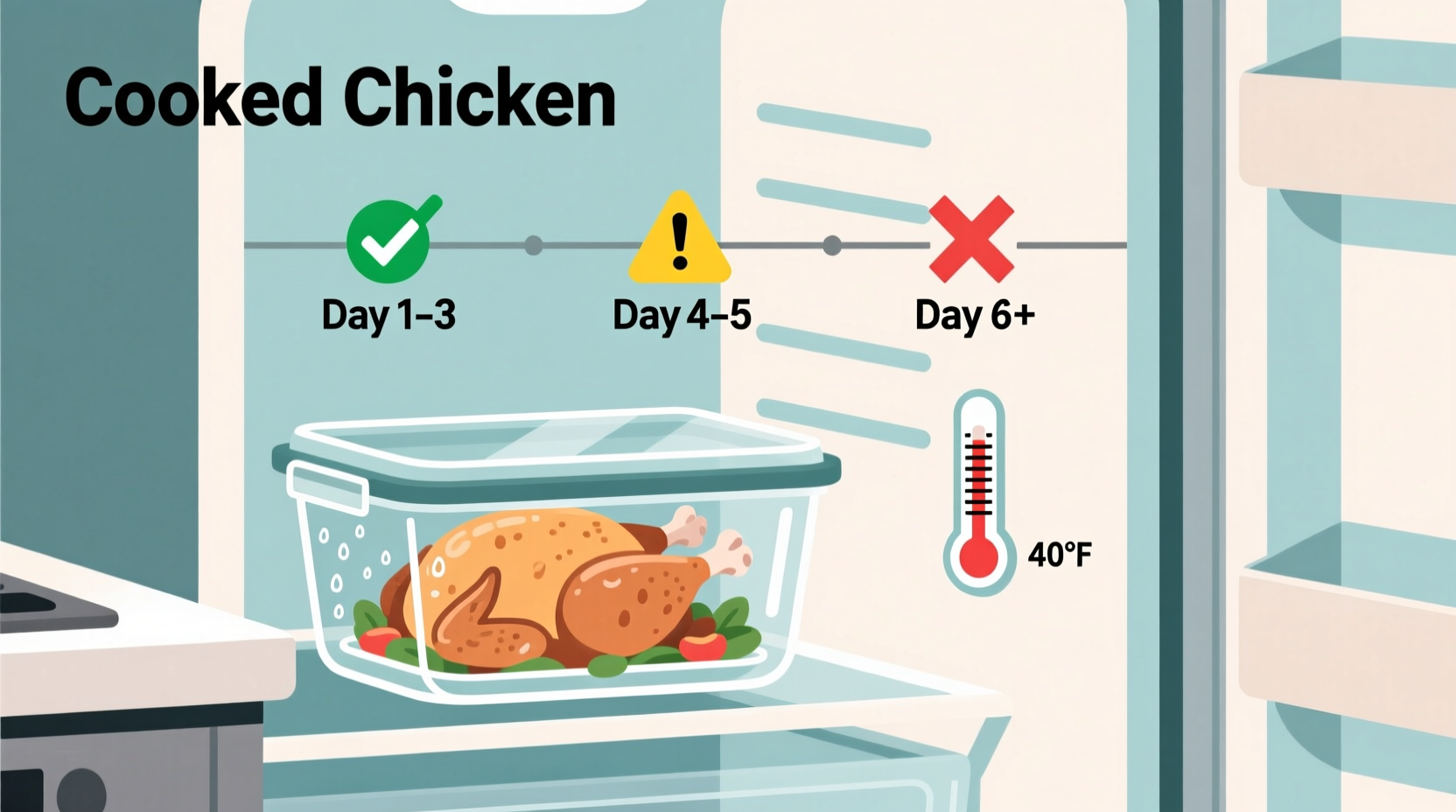Understanding how long your cooked chicken remains safe isn't just about avoiding waste—it's critical food safety knowledge that protects you and your family from potentially serious illness. Millions of food poisoning cases each year stem from improper leftover handling, with poultry being a common culprit.
What Happens to Cooked Chicken in the Refrigerator
When you store cooked chicken correctly, you're creating an environment where dangerous bacteria like Salmonella and Campylobacter can't multiply rapidly. The USDA Food Safety and Inspection Service confirms that properly refrigerated cooked poultry remains safe for consumption for 3-4 days. Beyond this window, bacterial growth accelerates significantly, increasing your risk of foodborne illness.
| Storage Method | Temperature | Safe Duration | Maximum Quality Period |
|---|---|---|---|
| Cooked chicken (whole pieces) | 40°F (4°C) or below | 3-4 days | 2-3 days |
| Cooked chicken (in broth/sauce) | 40°F (4°C) or below | 3-4 days | 3-4 days |
| Cooked chicken (shredded/diced) | 40°F (4°C) or below | 3-4 days | 2 days |
| Cooked chicken (frozen) | 0°F (-18°C) or below | 4 months | 2-3 months |
This evidence-based timeline comes directly from the USDA Food Safety and Inspection Service, which monitors foodborne illness data and establishes science-backed storage guidelines.
Immediate Post-Cooking: The Critical First Hour
How you handle chicken immediately after cooking determines its entire storage lifespan. Many home cooks make the critical error of leaving cooked chicken at room temperature too long before refrigerating.
The Centers for Disease Control and Prevention emphasizes the "2-hour rule": cooked food shouldn't remain in the temperature danger zone (40°F-140°F) for more than 2 hours. When room temperature exceeds 90°F, this window shrinks to just 1 hour.
Proper cooling technique:
- Slice or dice large pieces to increase surface area
- Divide large portions into smaller, shallow containers
- Place containers in an ice bath while stirring occasionally
- Refrigerate within 2 hours of cooking completion

Optimal Refrigeration Practices for Maximum Safety
Not all refrigerator storage methods provide equal protection. Your container choice, placement in the fridge, and packaging technique significantly impact how long your chicken remains safe.
Air-tight containers prevent:
- Cross-contamination with other foods
- Moisture loss that accelerates spoilage
- Absorption of refrigerator odors
- Exposure to airborne bacteria
Store cooked chicken on middle or upper shelves—not in the door where temperature fluctuates most. The back of the refrigerator typically maintains the most consistent temperature.
Spoilage Signs You Must Recognize
While the 3-4 day rule provides a safety guideline, actual spoilage can occur earlier depending on initial handling. Learn these critical warning signs:
Visual indicators:
- Grayish or greenish discoloration (not just browning from cooking)
- Visible mold in any color (white, green, black)
- Unusual slimy film on surface
Olfactory warning signs:
- Sour or sulfur-like odor (distinct from normal cooking aromas)
- Ammonia-like smell
- Generally "off" odor that seems unnatural
Tactile changes:
- Excessively slimy or sticky texture
- Unusual softness or mushiness
If you notice any of these signs, discard the chicken immediately—don't risk tasting it first. The USDA states that harmful bacteria that cause foodborne illness often don't produce noticeable changes in food.
Safe Reheating Procedures for Leftover Chicken
Proper reheating destroys bacteria that may have developed during storage. Follow these science-backed reheating guidelines:
- Heat to internal temperature of 165°F (74°C) measured with a food thermometer
- Reheat only the portion you plan to eat (repeated heating/cooling cycles accelerate spoilage)
- If using microwave, cover and rotate food for even heating
- Add moisture (broth or water) to prevent drying during reheating
When reheating chicken in sauces or gravies, bring the liquid to a rolling boil before adding the chicken to ensure thorough heating.
Freezing Cooked Chicken: Extending Safety Timeline
Freezing properly cooked chicken extends its safety timeline significantly. When frozen at 0°F (-18°C) or below:
- Whole pieces maintain best quality for 4 months
- Chicken in broth or sauce lasts 6 months
- Shredded or diced chicken stays freshest for 2-3 months
For best results when freezing:
- Use freezer-safe containers or heavy-duty freezer bags
- Remove as much air as possible to prevent freezer burn
- Label with contents and date
- Thaw in refrigerator—not at room temperature
Special Considerations for Different Chicken Preparations
Certain preparations affect storage timelines:
- Chicken salad: 3-5 days due to mayonnaise content (USDA)
- Chicken soup/stew: 3-4 days (same as plain chicken)
- Breaded chicken: 3-4 days (breading doesn't extend shelf life)
- Gravy-covered chicken: 2 days (moist environment encourages bacterial growth)
Any chicken dish containing dairy, eggs, or mayonnaise has a shorter safe storage window than plain cooked chicken.
Common Mistakes That Shorten Chicken's Refrigerated Life
Avoid these frequent errors that put your health at risk:
- Storing still-warm chicken directly in the refrigerator
- Using containers that aren't truly airtight
- Placing leftovers on refrigerator door shelves
- Reheating multiple times
- Ignoring "best by" dates on store-bought cooked chicken
Remember that "I've eaten chicken after a week with no problems" isn't reliable evidence—foodborne illness symptoms often appear 12-72 hours after consumption, making it difficult to connect illness to specific food.
When in Doubt, Throw It Out
The most important food safety rule requires no special equipment or expertise. If you're uncertain about how long chicken has been stored, or if it shows any questionable signs, discard it immediately. The minor cost of replacing food pales in comparison to medical bills from food poisoning or the discomfort of illness.
Food Safety Resources for Continued Learning
Stay updated with the latest food safety guidelines from these authoritative sources:











 浙公网安备
33010002000092号
浙公网安备
33010002000092号 浙B2-20120091-4
浙B2-20120091-4